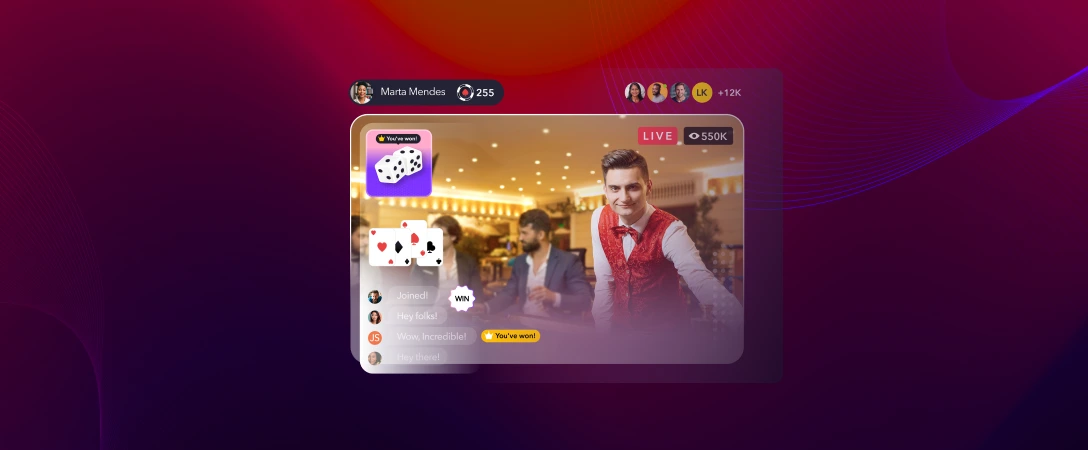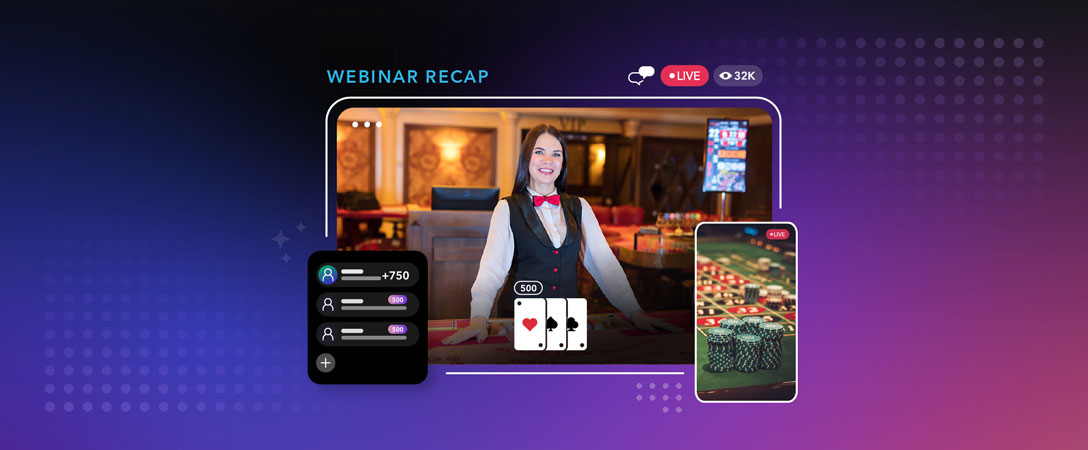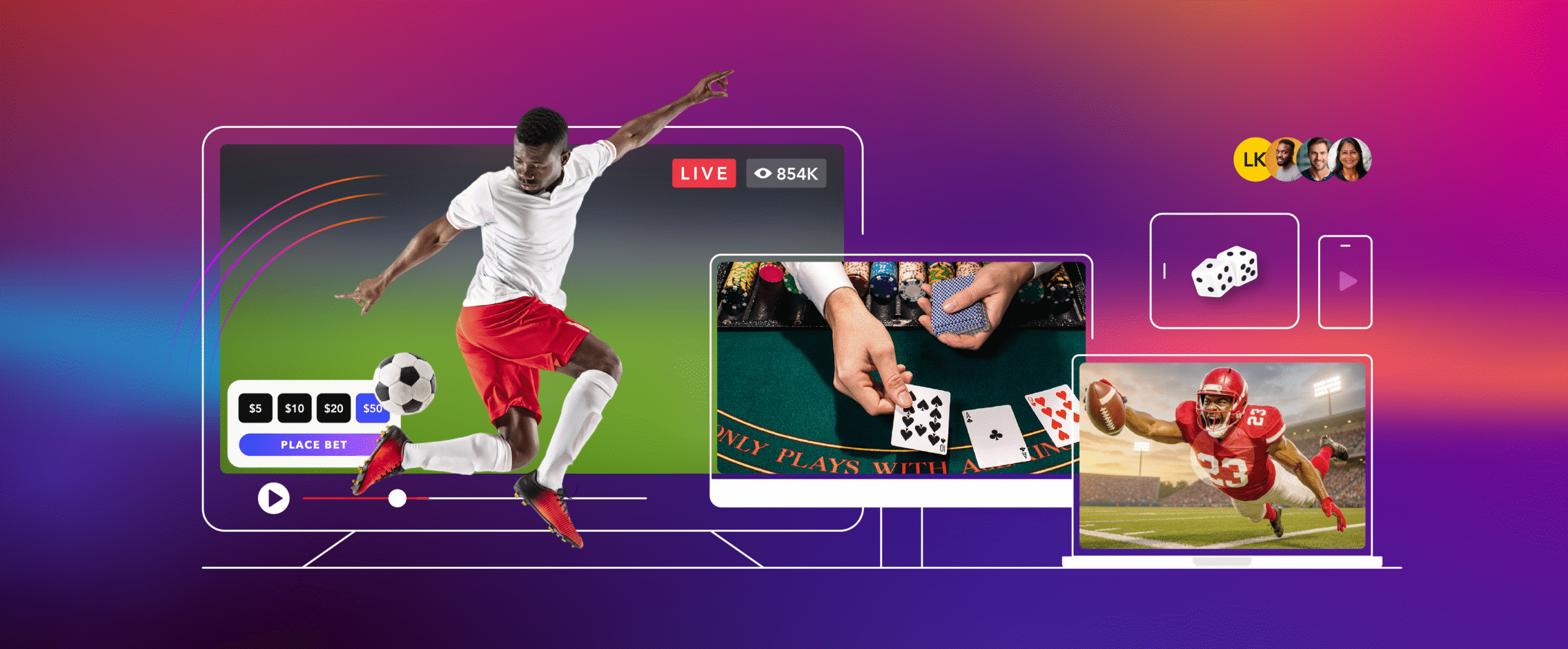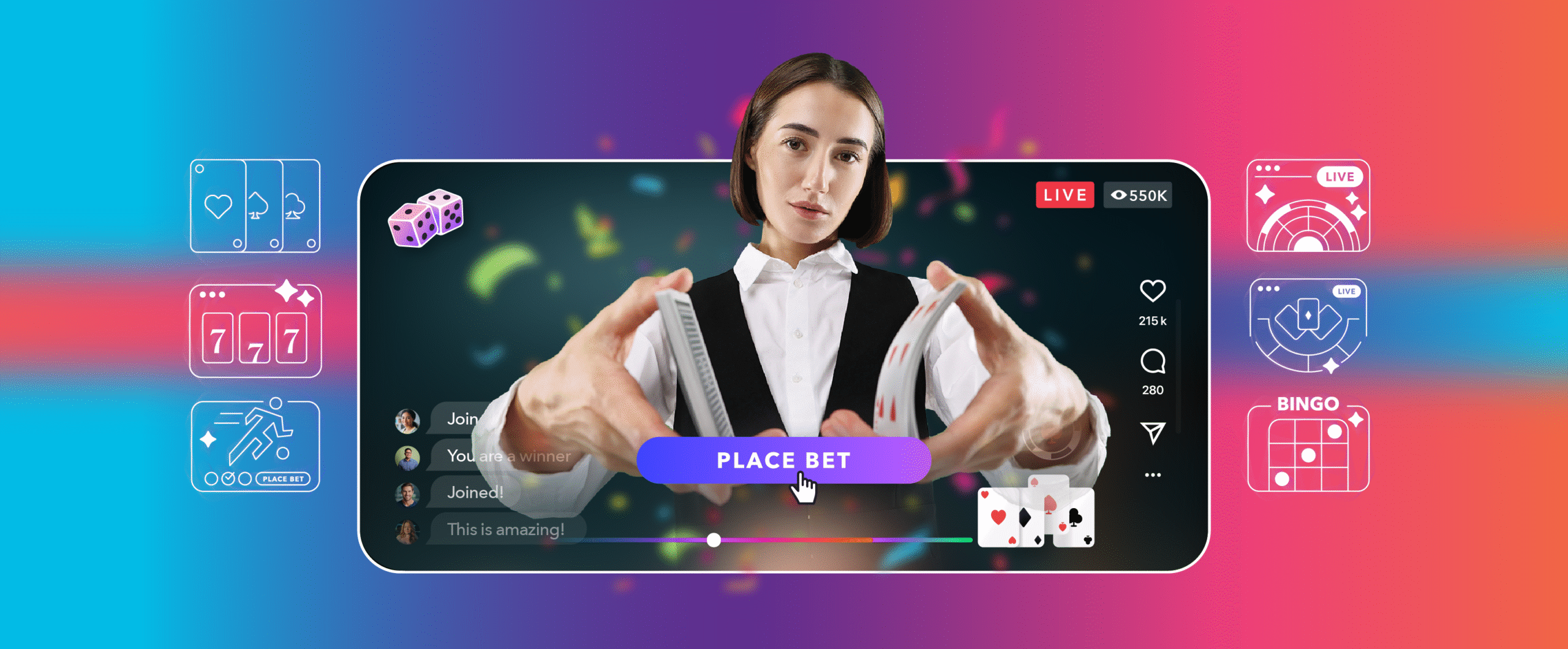The iGaming industry relies on real-time streaming to enhance player-dealer interaction and increase profits for live-dealer casino game providers.
However, this type of streaming has unique requirements, ranging from specific latency to security needs. Sometimes, one requirement comes at the expense of another, so finding the perfect streaming setup is crucial.
In this article, we will discuss the fundamentals of live-dealer streaming. We’ll start by covering the basics of live streaming for iGaming. From there, we’ll dive deeper into the special requirements for streaming in this industry and review the technologies used to bring these streaming setups to life.
The basics of online casino live streaming for iGaming
Live streaming is a major revenue generator for casinos since it opens doors for live dealer gaming and online betting. This bridges the gap between video gaming and gambling in brick-and-mortar casinos, which has created significant opportunities for the industry.
By adding a digital element to your table games, you blow the cap off your potential market since it allows you to reach customers who aren’t in the physical vicinity of your business. Naturally, this also unlocks untapped earning potential.
Furthermore, when you create digital experiences, gathering data and analytics on your customers is much easier. These insights are extremely valuable since it can be leveraged to inform business decisions and shape your strategy to grow.
Streaming requirements for live dealer casino games
As we mentioned, casino streaming has some unique requirements due to the nature of the content. Latency, security, streaming quality, and scalability are all critical aspects to consider as you build your streaming iGaming streaming setup.
Let’s take a moment to explore each of these aspects and their implications for casino streaming.
Real-time latency
Low latency streaming is essential for iGaming. Since live dealer gaming is interactive, creating an experience from the camera to the players’ screens in as close to real time as possible is typically valuable. Most iGaming providers target sub-second latency, but it’s important to note that live dealer casino games have varying latency needs.
Games that rely on player decisions, like card games, will perform better with sub-second latency. While roulette can still be played with higher latency, a lower latency allows for more bets and more profit to be made. A game like the vertical wheel, which is popular for its high concurrency, does not necessarily require ultra-low latency, but it needs to be able to handle a large number of simultaneous viewers.
Another factor to consider when discussing latency is the location of your players. In countries with less stable network infrastructure, such as Brazil, India, or the Philippines, some providers may use a higher latency approach to ensure an acceptable viewing experience.
Security
Another key factor in effective iGaming streaming is content protection. Currently, most live dealer casino game streaming happens with clear content. This means anyone can take your content, potentially steal it, re-stream it, and use it for cheating.
Basic tokenization is the first layer of protection used by live dealer casino games. However, ensuring it’s fully integrated with your backend to grant access is vital. Otherwise, it can be easily hacked. To ensure maximum security, working with a video streaming service that integrates the tokenization flow with your user management system is best.
While tokenization can protect your stream, it doesn’t necessarily protect the content itself. You’ll need to add digital rights management (DRM). DRM allows you to encrypt the content and deliver it in a way that is similar to Hollywood studios. This is particularly useful for legal and compliance teams within live casinos.
You may also need to consider geoblocking. It allows you to restrict streaming access to specific geographic regions or personalize content by incorporating different graphics tailored to particular areas. This can come in handy for complying with local casino laws.
High-quality streaming
While a nice studio setup, presenters, and interesting games are a minimum requirement to attract players, a high-quality experience will keep them engaged. Viewer expectations are continuing to increase, so casinos are challenged to
In order to ensure a high-quality stream, you’ll need to consider the resolution, bitrate, and frame rate.
- Resolution: The stream should be suitable for any device
- Bitrate: Adaptive Bitrate (ABR) streaming delivers an optimal viewing experience for any network condition
- Frame rate: Many studios produce streams at 50-60 frames per second (fps) but usually distribute at a lower frame rate
It’s also important to ensure a quick start-up time. The players are there to spend money, so you don’t want to keep them waiting any longer than they have to.
Scalability
Scalability is crucial for casinos that intend to grow their live dealer gaming operations, especially if their vision involves reaching players in different countries. You need a scalable infrastructure if you want to be able to provide high-quality content to your entire audience
A critical part of scalability is the cost associated with scaling. Typically, businesses are better off buying a streaming solution instead of building one on their own. Building your setup requires investing in more tools, servers, and so forth.
When you use a trusted streaming solution like Dolby, you’ll likely pay a bit more in usage fees as you scale, but this is a nominal expense compared to the resources and effort it takes to build your own host.
Key protocols for successful online casino live streaming
Checking all of the boxes for casino and iGaming streaming requires the support of the right streaming technology. A considerable part of this is choosing the correct streaming protocols.
Fortunately, several streaming protocols, including WebRTC and HESP, are available to help you achieve different streaming goals. Let’s review your options.
WebRTC
WebRTC is a real-time communication protocol specifically designed for web-based communication. It uses the UDP protocol to provide faster communication with a sub-500ms latency.
Although its real-time latency is valuable for streaming certain games, WebRTC has some notable drawbacks. The main downfall is that it brings susceptibility to frame drops due to network congestion and a lack of DRM protection.
Also, WebRTC’s architecture uses a point-to-point connection between the streaming server and the clients, making it complex and expensive to scale. Instead of using a standard CDN like traditional HTTP-based streaming protocols, it scales by spinning up additional streaming servers in the backend.
HESP
The High Efficiency Streaming Protocol (HESP) is an HTTP-based streaming protocol designed to deliver premium content with low latency.
It can quickly scale over standard content delivery networks (CDN), just like HLS and DASH, making it suitable for any size of audience, including global distribution to thousands of viewers. HESP also brings a fast channel start-up and support for studio-approved DRM.
This protocol streams with a latency of around a second, so it is best suited for games that benefit from one or more seconds of latency.
HLS & DASH
HLS and MPEG-DASH are protocols designed to stream high-quality content to large audiences. While these protocols offer a high-quality experience, they have a significant disadvantage in terms of latency.
These protocols work by chopping up a long video stream into segments of 10 seconds or more, requiring the video client to download a complete segment before it can be played, introducing 10-45 seconds latencies. The low latency variants, LL-HLS and LL-DASH, reduce latency to 3-7 seconds.
However, further reducing the latency to achieve stable and high-quality real-time streaming, such as sub-second latency, is impossible. The HLS and DASH formats do offer content protection, including support for studio-approved DRM solutions.
WebSocket
WebSockets has a similar architecture to WebRTC, including its scaling challenges. However, it has advantages, such as a lower risk of frame drops, better perceived quality, and compatibility with various browser types.
The video quality of a WebSocket-based approach is higher than that of WebRTC but lower than that of HTTP-based approaches such as HESP, HLS, and DASH. Additionally, WebSockets still have issues with very slow start-up times (up to 5 seconds) and lack support for studio-approved DRM.
Streaming needs for different iGaming use cases
Although the protocols we’ve covered are different, one is not inherently better than the next. However, one protocol may be better suited for a specific casino live streaming use case than another.
When choosing the proper protocol for delivering your video stream, it is essential to consider the use case and decide based on the most important criteria for you. Think about latency, viewer locations, scalability, channel start-up time, and requirements for DRM if cheating is common in your audience’s locations.
That said, here are a few examples of the streaming needs for various iGaming use cases.
Example 1: Roulette game to Eastern European customers
In a roulette game, achieving sub-second latency is ideal, although working with slightly higher latencies can still be acceptable. Video quality and stability are essential, given the immersive nature of the game.
Considering the game’s high concurrency, scalability becomes a crucial factor. Additionally, fast start-up time is highly valued. In Eastern Europe, the risk of cheating is relatively lower, making DRM less of a necessity in this case.
Example 2: Card game to APAC region
Low latency, high-quality video, and stability are top priorities in this use case. Scalability is not critical for a card game unless it gains significant popularity. Given the importance of network conditions in this region, ensuring a smooth and reliable streaming experience is crucial.
Lastly, prioritizing security is paramount, making DRM the optimal choice for safeguarding the game content in this scenario.
Example 3: Wheel of Fortune to EU/USA market
When delivering the Wheel of Fortune game to European and USA geographical regions, latency becomes less critical, allowing various protocols to function effectively.
However, ensuring high-quality and stable gameplay remains vital for an exceptional viewer experience. Given the game’s popularity, scaling capabilities should be optimized to seamlessly accommodate increased demand.
Additionally, network conditions in these regions are typically favorable, reducing the risk of interruptions. While the risk of cheating may be lower, maintaining security measures remains important to preserve the integrity of the game.
Example 4: Live sports betting to Latin America
Live sports betting is extremely popular in the Latin American market, particularly in horse racing. The nature of live betting calls for real-time latency to create a fair game for all players.
Since this is a rapidly growing market, a scalable streaming setup is crucial. DRM and security are also crucial elements to protect against the growing cybersecurity threats in this market.
Final thoughts
Although streaming live dealer casino games has some specific requirements, a powerful streaming solution like Dolby offers everything you need to support your operations.
From real-time latency to a scalable infrastructure, Dolby is here to help you create a powerful user experience, no matter where your players are from or what devices they use. We deliver immersive gameplay anywhere, anytime.
Contact us today to learn how we can help your casino find success in the world of iGaming.









